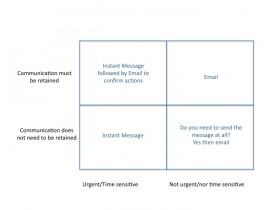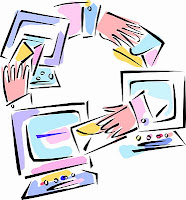Can Instant Messaging (IM) help to significantly reduce email overload? Over the last few months I’ve been working remotely with a client and using their IM in earnest (via Microsoft Communicator). I was able to catch up with colleagues on business and social matters quickly and without ending up with an inbox full of redundant email chains.
At one point urgent help was needed from a colleague whose status was ‘busy’. A quick message and back came the necessary data with a note that all the other matters would need to wait until our planned conference call later that week. Still the vital data was supplied and work could progress.
Would the same have happened with email? No, as he is a strict disciple of the ‘stay focused’ management school. His new email alerts are off and he only checks his inbox every couple of hour or so. He works on the basis that if it is urgent someone will either call or send him an IM.
Email has been around for just over 30 years and is now seen by many as the default communications channel. But is it really that useful for all electronic communications? Mimecast found only about 30% of emails received are read. Meanwhile the Grossman Group found that middle managers are overwhelmed by email and often spend long hours outside work catching up with their email. But what are all these emails they feel they must read or at least spend time deleting)? We and Grossman found that about 25 to 30% are indeed trivial often either chains (ongoing conversations) or about subjects that are no longer relevant (eg fire alarm is being tested at 11.00am).
Email is but one of a range of communications channels (from face-to-face meetings to text messaging). Is it time to start thinking through how we can use alternatives to email firstly to communicate more efficiently and hence secondly reduce the email overload which is crippling many people and their businesses? Have you checked recently how much time you and your business are loosing through unnecessary (internal junk) email?

For me IM is hugely undervalued as a communications tools. If I were CEO of an organisation (no matter what size) I would not ban email internally as some have done but would implement an IM policy.
All message which do not need to be retained and are time sensitive should be sent by IM and not email as per this matrix.
Are you using any form of social media and IM to reduce the volume of email traffic and improve communications? Click here to participate in our new survey.
Tags: alternatives to email, email chains, email management, email overload, IM, Mesmo Consultancy
Its Green Office Week this week and stopping email overload is one way to make a very significant contribution to reducing your carbon foot print.
 |
| Green Email Usage |
If your office and desk space was awash with papers you wouldn’t just go and ask for a new desk/larger office. You would be forced to clear up. Yet with email most people tend to ignore the warnings about mailbox sizes. Old emails are simply moved to another destination (for Outlook users often a pst file) and the inbox allowed to overflow again.
Unlike paper we can not see our emails, but make no mistake the more emails the more energy needed to process them. Even if you opt for email archiving to reduce the storage requirements, servers and energy is still needed to process them.
The main suppliers of email like Google, Microsoft and BT all promote large inboxes as an advantage. In my book this is amoral as it increases our carbon foot print and encourgaes email overload. It’s akin to the banks lending to people who could not aford to repay the loan. Instead of promoting bloated inboxes, responsible email providers should be promoting and rewarding those who downsize and maintain small sustainable inboxes.
Many business are now downsizing their office space to reduce overheads and be more sustainable. We should be doing the same with email to reduce our carbon foot prints. For example, reduce the volume of traffic through our inbox by reducing the number of emails chains, better email etiquette, sharing rather than sending the complete file.
During the week I will tweet more tips on how going green can also help you stop email overload.
Tags: BT, email chains, email etiquette, email overload, empty inbox, green office week, Microsoft
Email chains are a major cause of email overload. You know the symptoms:

Then there is the corollary – people who feel left out and feel they should be included. Take a look and see what percentage of the emails in your inbox relate to a thread/chain? How many of the iterations do you really need? Probably less then 25%. Little wonder email overload is on the increase.
Email chains seem to be the bane of most people’s life at the inbox. There are several ways to manage these more successfully which range from personal email management techniques to better use of the software. Here are the top three, some of which were in our October 2011 ‘ebriefing’ on tips to help you overcome email overload and use brilliant email etiquette to save time.
The key is to stop the email chain once it gets out of hand and re-assess just what you are trying to achieve and who really needs to make an input.
During the week there will be more tips on managing email chains.
Tags: email best practice, email chains, email overload